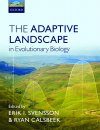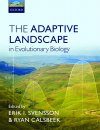About this book
The 'Adaptive Landscape' has been a central concept in population genetics and evolutionary biology since this powerful metaphor was first formulated by Sewall Wright in 1932. Eighty years later, it has become a central framework in evolutionary quantitative genetics, selection studies in natural populations, and in studies of ecological speciation and adaptive radiations. Recently, the simple concept of adaptive landscapes in two dimensions (genes or traits) has been criticized and several new and more sophisticated versions of the original adaptive landscape evolutionary model have been developed in response. No published volume has yet critically discussed the past, present state, and future prospect of the adaptive landscape in evolutionary biology. This volume brings together prominent historians of science, philosophers, ecologists, and evolutionary biologists, with the aim of discussing the state of the art of the Adaptive Landscape from several different perspectives.
Contents
Preface, Erik I. Svensson and Ryan Calsbeek
PART I: Historical Background and Philosophical Perspectives
1: A Shifting Terrain: A Brief History of the Adaptive Landscape, Michael R. Dietrich and Robert A. Skipper, Jr.
2: Sewall Wright's Adaptive Landscape: Philosophical Reflections on Heuristic Value, Robert A. Skipper, Jr. and Michael R. Dietrich
3: Landscapes, Surfaces and Morphospaces: What are they good for?, Massimo Pigliucci
PART II: Controversies: Fisher's Fundamental Theory Versus Sewall Wright's Shifting Balance Theory
4: Wright's Adaptive Landscape versus Fisher's Fundamental Theorem, Steven A. Frank
5: Wright's Adaptive Landscape: Testing the Predictions of his Shifting Balance Theory, Michael J. Wade
6: Wright's Shifting Balance Theory and Factors Affecting the Probability of Peak Shifts, Charles J. Goodnight
PART III: Applications: Microevolutionary Dynamics, Quantitative Genetics, and Population Biology
7: Fluctuating Selection and Dynamic Adaptive Landscapes, Ryan Calsbeek, Thomas P. Gosden, Shawn R. Kuchta, and Erik I. Svensson
8: The Adaptive Landscape in Sexual Selection Research, Adam G. Jones, Nicholas L. Ratterman, and Kimberly A. Paczolt
9: Analysing and Comparing the Geometry of Individual Fitness Surfaces, Stephen F. Chenoweth, John Hunt, and Howard D. Rundle
10: Adaptive Accuracy and Adaptive Landscapes, Christophe Pélabon, W. Scott Armbruster, Thomas F. Hansen, Geir Bolstad, and Rocío Pérez-Barrales
11: Empirical Insights into Adaptive Landscapes from Bacterial Experimental Evolution, Tim F. Cooper
12: How Humans Influence Evolution on Adaptive Landscapes, Andrew P. Hendry, Virginie Millien, Andrew Gonzalez, and Hans C. E. Larsson
PART IV: Speciation and Macroevolution
13: Adaptive Landscapes and Macroevolutionary Dynamics, Thomas F. Hansen
14: Adaptive Dynamics: a Framework for Modelling the Long-Term Evolutionary Dynamics of Quantitative Traits, Michael Doebeli
15: Adaptive Landscapes, Evolution, and the Fossil Record, Michael A. Bell
PART V: Development, Form, and Function
16: Mimicry, Saltational Evolution, and the Crossing of Fitness Valleys, Olof Leimar, Birgitta S. Tullberg, and James Mallet
17: High-dimensional Adaptive Landscapes Facilitate Evolutionary Innovation, Andreas Wagner
18: Phenotype Landscapes, Adaptive Landscapes, and the Evolution of Development, Sean H. Rice
PART VI: Concluding Remarks
19: The Past, the Present, and the Future of the Adaptive Landscape, Erik I. Svensson and Ryan Calsbeek
Index
Customer Reviews
Biography
Erik Svensson is professor in evolutionary ecology at Lund University Sweden. He obtained his PhD in 1997, and has performed research in Sweden, California, Greece, South Africa, and Japan on several different organismal groups, including birds, reptiles, crustaceans, and insects. He is a former Fulbright Scholar and postdoctoral researcher at University of California, Santa Cruz and a visiting Fellow at Stellenbosch Institute for Advanced Study in South Africa. Svensson's research interests are evolutionary processes in natural populations, including interactions between natural and sexual selection, life-history biology, genetic polymorphisms and frequency-dependent selection, mate preference evolution, sexual isolation, and speciation processes. He has published about 70 articles in international journals, and he currently serves in the international boards of American Naturalist and Evolution. He is currently member of the governing council for the European Society for Evolutionary Biology.
Ryan Calsbeek is a former post-doctoral fellow at the Center for Tropical Research at University of California, Los Angeles, a visiting scholar at the National Evolutionary Synthesis Center, and a visiting professor at Piere and Marie Curie Universite in Paris, France. Calsbeek's research focuses on the ecological and evolutionary factors that influence the strength and form of natural selection in natural populations of reptiles and amphibians, including predation, competition, and conflicts between the sexes. He is currently an Associate Professor of Biological Sciences at Dartmouth College in the U.S.A. Clasbeek has published 50 articles in international peer-reviewed journals and currently serves as an Associate Editor on the journal Functional Ecology.

































